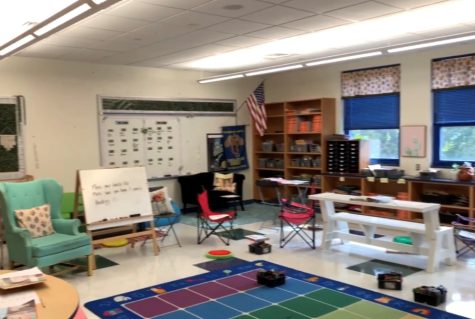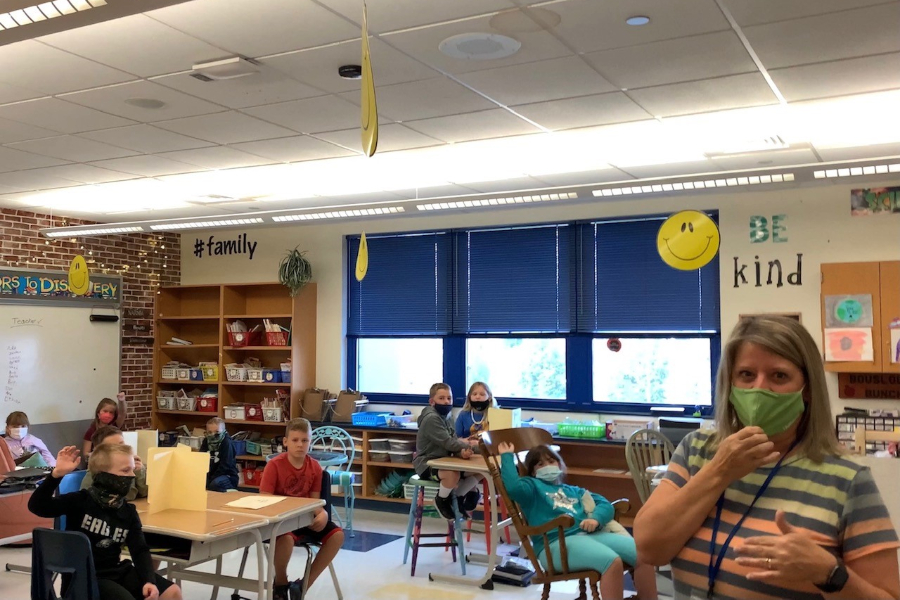Mrs. Bouslough is one of four third grade teachers at Myers who have adopted flexible seating in their classrooms.
Flexing their muscles
Myers teachers use new seating arrangements to reach new students
November 5, 2021
Education is constantly changing. With younger teachers replacing older ones, teaching methods advance to fit the modern, technology-driven future. Antiquated items, such as; paper, chalkboards, and analog clocks have been replaced by their modern counterparts.
Even things like chairs are getting an update, as teachers turn to flexible seating arrangements.
At Myers Elementary, the third grade team has taken on the approach of flexible seating with open arms this year.
“Flexible seating classroom replaces typical school desks and chairs with other seating options, such as stability balls, gamer chairs, couches, and rocking chairs that students can chose to use,” says Mrs. Erin Kelly, who is a strong proponent of the arrangement. Mrs. Kelly is joined by grade level team members Susan Bouslough, Sammy Sabatula, and Allison Claybaugh in championing the new way of configuring the classroom.
The Right Choice
For teachers like Allison Claughbaugh, who has encouraged students to move around and be active most of her career, flexible seating has been a natural progression. She has been teaching in a way that could be called flexible seating even before flexible seating was a buzz word.
“Most of my direct instruction happens on the carpet,” she said.
Myers teachers agree that flexible seating is used to give the students a sense of ownership in their classrooms, while providing an outlet for the energy most young people bring to school.
At Myers, there are many different options the students get to pick from. There are yoga balls, camp chairs, carpet squares, places students can stand up to work, and many others. There is even regular seating in desks for those students who prefer standard seating.
Mrs. Kelly likes the idea of providing outlets young peoples’ energy because, she said, “Kids are prone to wiggle.”
“At this age they are always moving, standing, and getting out of their seats,” said Mrs. Kelly.
Now that flexible seating is an option for teachers, they find it is easier for kids to pay attention.
The right choice is a very important privilege that comes out of allowing students to pick what works best for their education, a skill that is constantly used in their classrooms.
In most cases at Myers, students get to choose what seat they want to use at the beginning of each week. Many kids either chose the seats on the floor with a table or the blue cushion chair, Mrs. Kelly said.
While they have an option for a traditional desk, most students don’t prefer that over the less traditional seats, Mrs. Kelly said. In fact, she said, there are usually one or two students that choose to sit at desks.
For teachers, having flexible seating means the need for strong classroom management, whether that means making sure kids don’t rock back and forth, make noise, or get distracted by the other seating around them. Teachers also oversee students picking out their seats so there isn’t any fighting.
So far, there haven’t been many complaints about flexible seating, Mrs. Kelly said. When there was a complaint, it was a misunderstanding about classroom control.
Making the Change
Changing to flexible seating was a nerve wracking experience, says Mrs. Clabaugh, but it was worth it.
Because it’s a major philosophical changes that involves a lot of preparation and a lot of nervousness, she’s not sure if other teachers will follow, but she is hoping that they will consider flexible seating or add some pieces of it.

Mrs. Clabaugh said she has seen improvements in students behavior and academic performance, which has eliminated a lot of fidgeting.
“The flexible seating environment pulls them away from a desk full of items that might otherwise distract them,” says Mrs. Clabaugh.
Beyond that, flexible seating simply provides an aesthetically pleasing environment that is different and engaging.
Mr. Stinson admits that for some there may be a stigma attached to the dramatic seating change, but he would like to see more teachers take similar leaps.
“Its very hard to break the stereotype that all classrooms must be in rows with the teacher talking the whole period because that is how so many of us were taught,” said Mr. Stinson. “However, introducing new methods should include all students needs.”
The Payoff
Having flexible seating has been beneficial for the students and teachers of Myers Elementary. Classroom environment can affect a child’s academic progress over a year. In fact, a study by the University of Minnesota found that 48% of students are more active in discussions with collaborative seating as an option.
“Fidgeting in the desks is a lot more noticeable than it is in flex seating, so it can be a big distraction for some,” Mrs. Kelly said.
Ultimately, Myers teachers feel flexible seating will lead to better student performance. Far from distracting, they feel the seating arrangement actually limits distractions.
“The flexible seating environment pulls them away from a desk full of items that might otherwise distract them,” says Mrs. Clabaugh.
However you cut it at the end of the day flexible seating is here to stay, “ The teachers that have chosen to use this type of seating are fully committed and do an amazing job of setting the expectations for the students and also building relationships that allow for this to be used effectively,” says Mr. Stinson.

Gondek Gayle • Nov 5, 2021 at 7:22 pm
Great article. I never heard of flexible seating. Good job explaining it😊